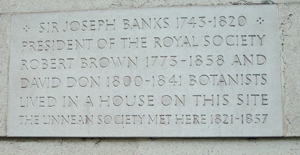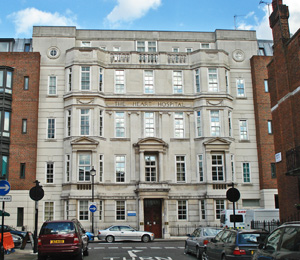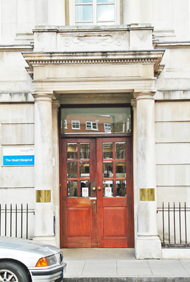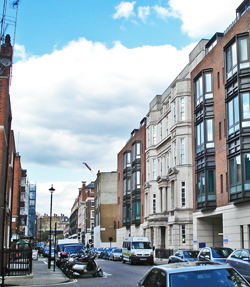National Heart Hospital
Westmoreland Street, W1M 8BA
Medical
dates:
Medical
character:
Specialist
The Hospital for Diseases of the
Heart was founded in 1857 by Dr Eldridge Spratt at No. 67 Margaret Street.
It is reputed to be the first hospital in the world dedicated to
the study and
treatment of heart disease and the first to introduce
postgraduate training.
For some years Dr Spratt was the only physician as well as the secretary and treasurer. Eventually a Committee was appointed, but turnover of members was high, and there was often trouble between the Committee and Dr Spratt.
In 1869 the Hospital moved to No. 83 Newman Street, just off Oxford Street.
From 1874 it moved again, this time to a fine house designed by the Adam brothers at No. 32 Soho Square, the former home of the naturalist, Sir Joseph Banks. The Hospital remained there for forty years.
The Hospital Committee had by this time endured many difficulties with Dr Spratt and, on 18th January 1875, he was asked to resign over some financial irregularities. He did, but returned that night to remove much of the contents of the Hospital - instruments, furniture, books, pictures, and a large quantity of lead - in a furniture van.
Following Dr Spratt's departure the running of the Hospital improved. Out-patient sessions were held regularly, the number of physicians on the staff having increased to four. The staff did not confine themselves to matters of the heart: publications in the late 19th century included 'Hints on Men and Women', The Effect of Education on the Industrial Classes' and 'Cycling as a Cause of Heart Disease'.
In 1910 a pathology department was opened in an iron shed, and the X-ray department in another. The Hospital's first electrocardiograph was purchased in 1911 though, for lack of room, it was housed at South Kensington. Patients were taken there by cab.
Plans for a new building were mooted in 1912 and the new Hospital at a site in Westmoreland Street was completed by 1914.
During WW1 the Hospital was one of the main centres for examination of the hearts of recruits referred by army medical boards. 10,000 were examined.
Regular out-patient teaching and courses were first held in 1919.
In 1948 the Hospital joined the NHS. The teaching programme was formalised as the Institute of Cardiology, which joined the British Postgraduate Medical Federation.
It gained an international reputation during the 1960s with the rapid development of cardiology and cardiac surgery. The first heart transplant in the UK took place here, as well as the first successful coronary angioplasty and coronary stent implantation in the UK. Numerous advances in pacing and electrophysiology were developed, along with advanced surgery for congenital heart disease.
In 1991 the Hospital closed and services moved to the Royal Brompton Hospital.
The building was sold to Gleneagles Hospital UK in 1994 and re-opened in 1997 as a private hospital specializing in cardiac treatment. However, the enterprise fell into debt and University College London Hospitals bought the building for £27m in 2001 to house the cardiac services that were then based at the Middlesex Hospital in Mortimer Street.
For some years Dr Spratt was the only physician as well as the secretary and treasurer. Eventually a Committee was appointed, but turnover of members was high, and there was often trouble between the Committee and Dr Spratt.
In 1869 the Hospital moved to No. 83 Newman Street, just off Oxford Street.
From 1874 it moved again, this time to a fine house designed by the Adam brothers at No. 32 Soho Square, the former home of the naturalist, Sir Joseph Banks. The Hospital remained there for forty years.
The Hospital Committee had by this time endured many difficulties with Dr Spratt and, on 18th January 1875, he was asked to resign over some financial irregularities. He did, but returned that night to remove much of the contents of the Hospital - instruments, furniture, books, pictures, and a large quantity of lead - in a furniture van.
Following Dr Spratt's departure the running of the Hospital improved. Out-patient sessions were held regularly, the number of physicians on the staff having increased to four. The staff did not confine themselves to matters of the heart: publications in the late 19th century included 'Hints on Men and Women', The Effect of Education on the Industrial Classes' and 'Cycling as a Cause of Heart Disease'.
In 1910 a pathology department was opened in an iron shed, and the X-ray department in another. The Hospital's first electrocardiograph was purchased in 1911 though, for lack of room, it was housed at South Kensington. Patients were taken there by cab.
Plans for a new building were mooted in 1912 and the new Hospital at a site in Westmoreland Street was completed by 1914.
During WW1 the Hospital was one of the main centres for examination of the hearts of recruits referred by army medical boards. 10,000 were examined.
Regular out-patient teaching and courses were first held in 1919.
In 1948 the Hospital joined the NHS. The teaching programme was formalised as the Institute of Cardiology, which joined the British Postgraduate Medical Federation.
It gained an international reputation during the 1960s with the rapid development of cardiology and cardiac surgery. The first heart transplant in the UK took place here, as well as the first successful coronary angioplasty and coronary stent implantation in the UK. Numerous advances in pacing and electrophysiology were developed, along with advanced surgery for congenital heart disease.
In 1991 the Hospital closed and services moved to the Royal Brompton Hospital.
The building was sold to Gleneagles Hospital UK in 1994 and re-opened in 1997 as a private hospital specializing in cardiac treatment. However, the enterprise fell into debt and University College London Hospitals bought the building for £27m in 2001 to house the cardiac services that were then based at the Middlesex Hospital in Mortimer Street.
Present status (April 2008)
The National Heart Hospital, having had a little holiday from the NHS, is once again part of it.
It is now known as The Heart Hospital.
Update: June 2015
In April 2015 some services moved to the new Barts Heart Centre at St Bartholomew's Hospital.
However, cardiology clinics will continue to be held at the Hospital for patients referred to University College Hospital. Thoracic surgery will continue to be provided, while urological services will move in later in the year..

The site of the Hospital at the turn of the 20th century - No. 32 Soho Square - is now occupied by Twentieth Century House, built in 1936, and currently offices for the film distributors 20th Century Fox.

A stone plaque on the building commemorates the site of the home of Sir Joseph Banks.

The front elevation of the Hospital in Westmoreland Street with its name - The Heart Hospital - on the frieze.

The main entrance with the brass plate bearing the legend 'The Heart Hospital'.

Looking towards the north along Westmoreland Street, the Hospital is the white building on the right in the image.
(Author unstated) 1939 The National Heart Hospital. A Multifarious Founder. British Medical Journal 2 (4121), 1280.
Black N 2006 Walking London's Medical History. London, Royal Society of Medicine Press.
Campbell M 1958 The National Heart Hospital 1857-1957. British Heart Journal 20, 137-139.
http://en.wikipedia.org
http://michaeloon.com
http://news.bbc.co.uk
http://scts.org
http://search.lma.gov
http://wellcomeimages.org
https://nicor4.nicor.org.uk
www.aim25.ac.uk
www.medicalarchitecture.com
www.nao.org
www.photographersdirect.com
www.pinterest.com
www.theguardian.com
Return to home page